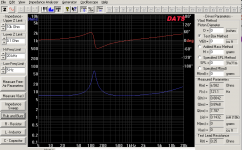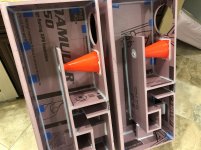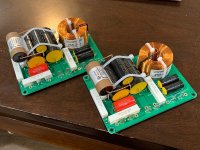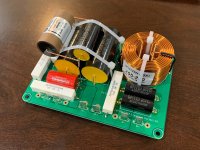Great.
Thanks for the comparative.
One last thing.
My B80 were quite off in specs from the online specs offered.
I assume you did run the drivers through DATS before going through all this trouble.
Did you find the same thing?
BTW, even though it might look like it, I am not complaining about the driver's sound.
I also felt it was very nice, but I wanted an opinion regarding it and the 10f.
Thanks for the comparative.
One last thing.
My B80 were quite off in specs from the online specs offered.
I assume you did run the drivers through DATS before going through all this trouble.
Did you find the same thing?
BTW, even though it might look like it, I am not complaining about the driver's sound.
I also felt it was very nice, but I wanted an opinion regarding it and the 10f.
Attachments
Last edited:
I posted this earlier, both drivers were similar. I never bothered to see if it matched the factory specs because in a sealed Dagger rear chamber, it doessn't really matter.
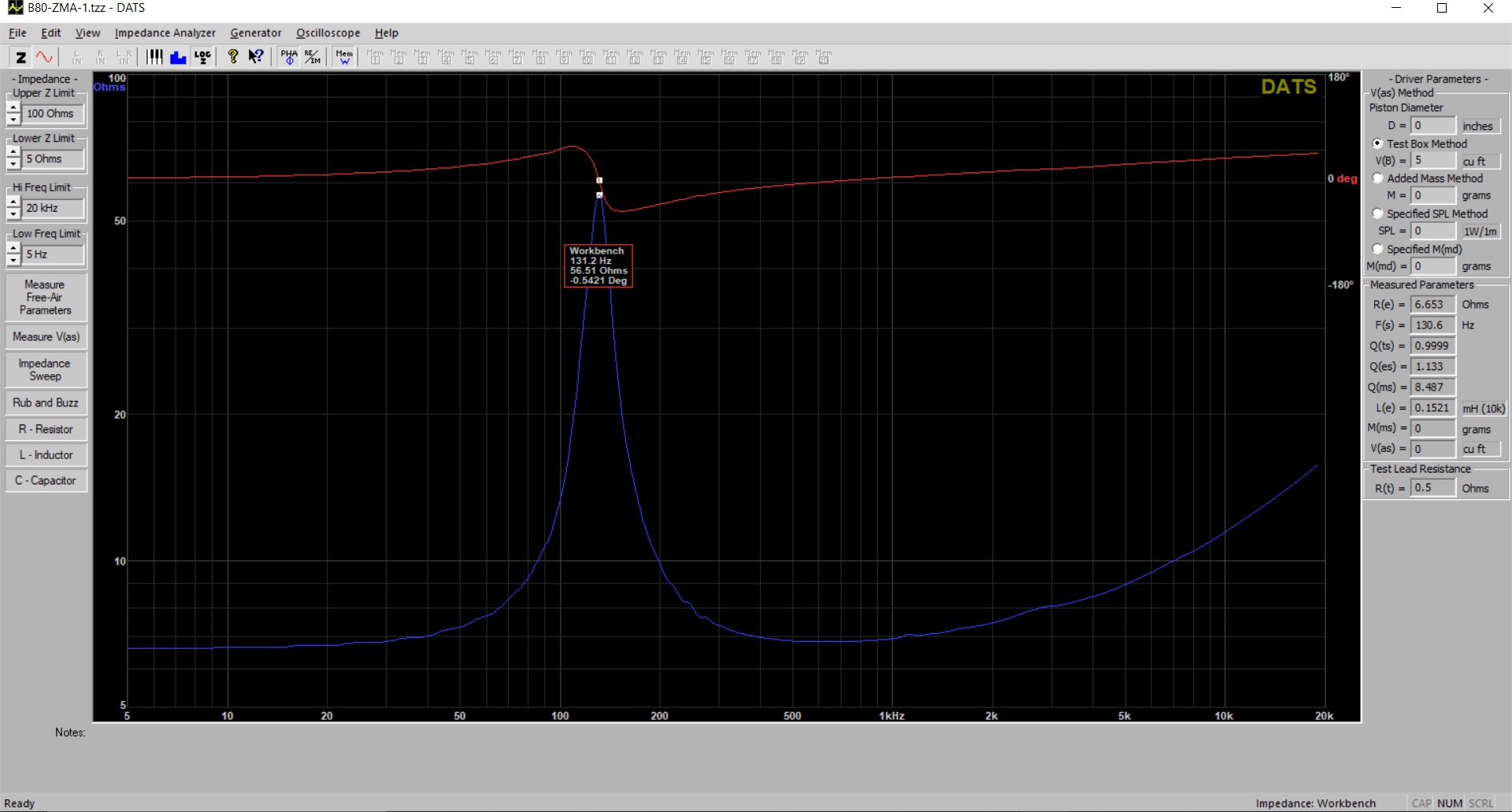
Spec sheet here:
https://www.parts-express.com/pedocs/specs/292-660--visaton-b80-spec-sheet.pdf
Factory spec says Qts is 0.63 and I got about 1.0 for both of my drivers, so appears the magnet is not as powerful as they specify - nothing new here. Even 10F/8424 doesn't measure as specified. However, 0.63 to 1.0 is a big difference. The Fs is close off by 15Hz and may lower with some more break in.
Spec sheet here:
https://www.parts-express.com/pedocs/specs/292-660--visaton-b80-spec-sheet.pdf
Factory spec says Qts is 0.63 and I got about 1.0 for both of my drivers, so appears the magnet is not as powerful as they specify - nothing new here. Even 10F/8424 doesn't measure as specified. However, 0.63 to 1.0 is a big difference. The Fs is close off by 15Hz and may lower with some more break in.
Trouble is... you don't know their setup....
I bought a set of mixing monitors that were touted to be extremely flat and perfect from Fostex..... Well... they were absolutely not flat!
The musician plays his notes the way he feels them, but his ears are not at the mic level, so what he hears is different from what is recorded, the engineer records them the way he feels to show off the musician best, the producer mixes the album the way he thinks will sound best on most radio out there, and many radio broadcast add they own EQ and loudness settings so it sounds more in your face when you listen to it on their station...
What are you listening to, again?
Even if you were in the room when they played and recorded, your position away from the band would have meant a different sound then the one the mics picked up.
It's all a question of perspective, and as long as you like what you hear, it's all good.
But believe me, what you are listening at home is certainly not as the musician heard while recording.
You are absolutely correct and we should all forget about hearing it as the artist and recording engineer intended. It will never happen and there's no way to know what they intended. Hifi audio listening should be all about making it sound as good as possible to the listener. That idea that we can hear it as the artist and engineer intended is not valid.
I've studied and taught this same principle with photography and visual media. It's a lot about viewing distance, resolution, circle of confusion, etc. The basic idea is that there are a number of controllable variables and a number of uncontrollable variables in the presentation of a piece. If we could control all of the variables, we could hear it or see it as the artist intended. For music, that would mean being in the same room with all the same equipment, same volume, standing in the same place and smoking the same dope...LOL
Dead Wood
I want to start a small discussion about our choice of 3/4" (11Ply) Baltic Plywood. We choose this material based on the research of a YouTube scientist with a channel called Tech Ingredients. You can see the critical point if you skip forward 25Min in this video: Worlds Second Best Speakers.

There a lot of talk about MDF being better than Plywood but I think this debunks that. Is he right? What do we know on this forum about materials for building speakers?
I want to start a small discussion about our choice of 3/4" (11Ply) Baltic Plywood. We choose this material based on the research of a YouTube scientist with a channel called Tech Ingredients. You can see the critical point if you skip forward 25Min in this video: Worlds Second Best Speakers.

There a lot of talk about MDF being better than Plywood but I think this debunks that. Is he right? What do we know on this forum about materials for building speakers?
Hi,
I want a picture of the anechoic chamber please from the YT link
Sounds like an ad. With the motor engine you will see a lot of threads that focus on the material cabinet here with some great specialists input. Your speaker looks fine, a little like a frugal-phil speaker.
@ xr971 : did you paneld, sorry planed (edit) to offer flat pack option with CNC cut for your foam open cells cabinet ? I also surmise today a rohacel horn for the little SS should not be so hard to outsource with your specs when all this cv-19 crisis will be finish ? Or a 3D print file ?
I want a picture of the anechoic chamber please from the YT link
Sounds like an ad. With the motor engine you will see a lot of threads that focus on the material cabinet here with some great specialists input. Your speaker looks fine, a little like a frugal-phil speaker.
@ xr971 : did you paneld, sorry planed (edit) to offer flat pack option with CNC cut for your foam open cells cabinet ? I also surmise today a rohacel horn for the little SS should not be so hard to outsource with your specs when all this cv-19 crisis will be finish ? Or a 3D print file ?
Last edited:
Diyiggy,
I am not sure what you are asking and about which speaker because there is no horn for the Scanspeak in this speaker. Are you talking about the Trynergy foam core speaker?
For the 10F/RS225 FAST TL speaker, we will have to see how the first set of speakers go. But a CNC cut speaker flat pack may be an option if we can find a suitable wood cutting vendor. There needs to be substantial interest to make it feasible.
I am not sure what you are asking and about which speaker because there is no horn for the Scanspeak in this speaker. Are you talking about the Trynergy foam core speaker?
For the 10F/RS225 FAST TL speaker, we will have to see how the first set of speakers go. But a CNC cut speaker flat pack may be an option if we can find a suitable wood cutting vendor. There needs to be substantial interest to make it feasible.
Sorry, question if for both, the other horned and the flat monitor (asking myself if with the water or laser cuting, open cells foam walls could be cut with 45° angles or with a step level in the width for a beter 90° assembly.
In the case one doesn't want to go with wood at all, I meant.
With rohacell (sealed cells foam) it's easy to shape U shapes (so front and sides in one piece and horns.
Well OT, just a blink eyes as the cabinet was suddenly asked. Forget it or put it aside
For the wood, a CNC file sale option is maybe an idea : greener !
In the case one doesn't want to go with wood at all, I meant.
With rohacell (sealed cells foam) it's easy to shape U shapes (so front and sides in one piece and horns.
Well OT, just a blink eyes as the cabinet was suddenly asked. Forget it or put it aside
For the wood, a CNC file sale option is maybe an idea : greener !
Last edited:
Anechoic Chamber is Real
He shows the chamber in one of his videos.
Hi,
I want a picture of the anechoic chamber please from the YT link
He shows the chamber in one of his videos.
I want to start a small discussion about our choice of 3/4" (11Ply) Baltic Plywood.
I specified 3/4in ply for this speaker once I decided to make it out of wood vs XPS foam. There are already plenty of threads discussing the merits of BB ply vs MDF. I chose 3/4in BB ply mostly because it is high quality, looks good, takes on stain and varnish nicely, and retains dimensional stability, and it is tougher than MDF. I am not opposed to making speakers out of MDF but the stuff make some nasty dust when cut or sanded. Regarding panel resonance or damping - I think with adequate bracing and judicious use of constrained layer damping (CLD), even foam core speakers or XPS boxes can be made to sound great. The measurements of the BB ply cabinet with Noico and eggcrate foam is not too much better than the original pink XPS foam box with thin 3/16in luauan subfloor ply baffle.
Here was my comparison of the speaker with XPS vs 3/4in BB ply cabinet:
10F/8424 & RS225-8 FAST / WAW Ref Monitor
XPS foam distortion at 2.83vrms:
3/4in BB plywood distortion at 2.83vrms:
Freq response comparison side-by-side, we can see the added stiffness improved the lower registers bass response quite a bit, but overall frequency response flatness, and distortion was not significantly better:
Last edited:
Updated Pics & Ply Thoughts
XRK - Sorry if this has been discussed previously. I'll try to find those discussions. I just brought up question about plywood to see what people though about that video. Maybe there is a better thread for that? I'm personally am in favor of using baltic birch plywood for all the same reasons you mentioned. MDF doesn't seem to have many good properties, other than being cheap and it's not really that cheap. XPS foam seems like a real winner. I'm very surprised by that frequency response comparison. I'll consider the XPS foam for future builds. It seems like it could easily be combined with ply, veneer, and acoustic treatments to make great speakers. I feel like 1/2" ply glues to 1/2" XPS could be nice. Can XPS be cut with a hot wire? I have some very large designs I want to build and I'll need to keep the weight down. These FAST TL speakers are going to be heavy but they will each be in three pieces: Base, Body, Top Hat.... so it's a good thing and should help performance.
Update Woodwork Pictures:




XRK - Sorry if this has been discussed previously. I'll try to find those discussions. I just brought up question about plywood to see what people though about that video. Maybe there is a better thread for that? I'm personally am in favor of using baltic birch plywood for all the same reasons you mentioned. MDF doesn't seem to have many good properties, other than being cheap and it's not really that cheap. XPS foam seems like a real winner. I'm very surprised by that frequency response comparison. I'll consider the XPS foam for future builds. It seems like it could easily be combined with ply, veneer, and acoustic treatments to make great speakers. I feel like 1/2" ply glues to 1/2" XPS could be nice. Can XPS be cut with a hot wire? I have some very large designs I want to build and I'll need to keep the weight down. These FAST TL speakers are going to be heavy but they will each be in three pieces: Base, Body, Top Hat.... so it's a good thing and should help performance.
Update Woodwork Pictures:




Progress looks great Studiomic! No worries about the discussion about MDF vs BB. Just use the search function in DIYA. The bevel around the vent looks great.
The XPS glued with a thin ply cover makes an excellent lightweight speaker. It can be cut with hot wire, table saw, or a sharp utility knife and metal straightedge over maybe 10 gradual strokes.
The XPS glued with a thin ply cover makes an excellent lightweight speaker. It can be cut with hot wire, table saw, or a sharp utility knife and metal straightedge over maybe 10 gradual strokes.
I want to start a small discussion about our choice of 3/4" (11Ply) Baltic Plywood. We choose this material based on the research of a YouTube scientist with a channel called Tech Ingredients. You can see the critical point if you skip forward 25Min in this video:
There a lot of talk about MDF being better than Plywood ...?
I'd be wary of YT videos with titles like "World's best...."
I actually watched a few of his videos before.
There is some info, but he is also very dogmatic in his views, and some of the stuff he says is just plain wrong. And when confronted, he just hides.
To me, there is no perfect one material out there.
The trick is to combine different materials. Each of them having a different resonance frequency, they dampen each other.
So, you are on the right path by suggesting XPS laminated with wood.
And yes, XPS is great for prototypes too. Cheaper, faster and easier to come up with an enclosure in XPS when trying stuff out!
I posted this earlier, ....
Factory spec says Qts is 0.63 and I got about 1.0 for both of my drivers, so appears the magnet is not as powerful as they specify - nothing new here. Even 10F/8424 doesn't measure as specified. However, 0.63 to 1.0 is a big difference. The Fs is close off by 15Hz and may lower with some more break in.
Yeah, when I ordered the B80, originally, I had made a TL for it, followings specs online.
When I received the units and measured them, I had to throw that idea away!
I placed them in the Nola Brio clones instead and they sang well in there.
perceval- I like your thinking on combining materials that dampen each other. That's the answer I was looking for when I posted about plywood. Using the rubbery glue that the "Worlds Best" Youtube scientist tested might be a good way to mate materials.
The "worlds best" thing is a marketing ploy and I think it's genus. I choose to believe he knew it was a ridiculous claim. Look at the number of hits! No one can resist seeing what it is all about.
The "worlds best" thing is a marketing ploy and I think it's genus. I choose to believe he knew it was a ridiculous claim. Look at the number of hits! No one can resist seeing what it is all about.
The "worlds best" thing is a marketing ploy.
might work for the masses... but myself, I see a title like that and I move on.
I know it's going to be full or errors, or just plain wrong, whether by ignorance or by design.
Anyway, do try multiple materials laminated together.
Myself, I have layered plywood, aluminium and stone. Free from any kind of resonance.
But that was another project.
Good luck with this one!
A little OT, but since it is my thread... 
I think 3/16in luauan subfloor ply (cheap but nice "mahogany like" finish) laminated with 1/2in XPS and another 3/16in luauan ply sandwich bonded with a pliable latex based subfloor adhesive would make a great ultralight speaker panel material. This would give a nominal 0.9in thick panel that can get cut and glued using butt joints reinforced with a ledger or gusset, or just plain old industrial adhesive or PL Premium.
My original XPS box with the 3/16in ply baffle feels like "air" once the drivers are removed. Reminds me of my earlier thread of the light as air subwoofer.
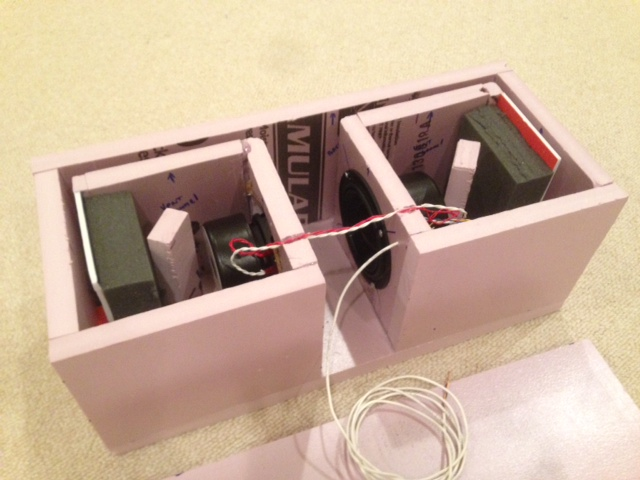
I should pull thouse out again, they sounded quite impressive and clean. Here is 2.83v at 1m driving a pair of 16ohm 5.25in woofers in parallel for nominal 8ohms.
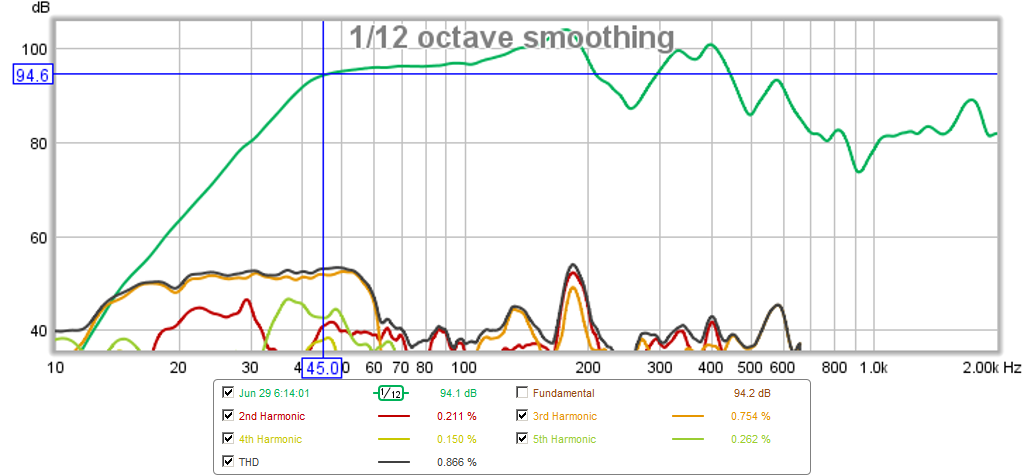
With some EQ and low pass and high pass filters, you can see that it provides nice fill for the low registers:
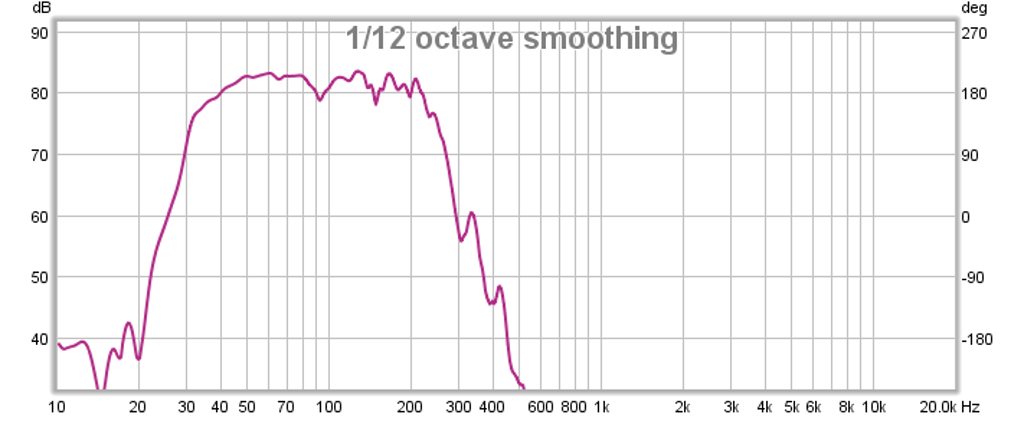
This could in fact, simply serve as the "stand mount" for a nice sealed top speaker like a pair of TC9FD's in a Nautaloss (or Dagger would work too), or a Nola clone:

Lot's of fun with foam can be had as you can see.
I think 3/16in luauan subfloor ply (cheap but nice "mahogany like" finish) laminated with 1/2in XPS and another 3/16in luauan ply sandwich bonded with a pliable latex based subfloor adhesive would make a great ultralight speaker panel material. This would give a nominal 0.9in thick panel that can get cut and glued using butt joints reinforced with a ledger or gusset, or just plain old industrial adhesive or PL Premium.
My original XPS box with the 3/16in ply baffle feels like "air" once the drivers are removed. Reminds me of my earlier thread of the light as air subwoofer.

I should pull thouse out again, they sounded quite impressive and clean. Here is 2.83v at 1m driving a pair of 16ohm 5.25in woofers in parallel for nominal 8ohms.

With some EQ and low pass and high pass filters, you can see that it provides nice fill for the low registers:

This could in fact, simply serve as the "stand mount" for a nice sealed top speaker like a pair of TC9FD's in a Nautaloss (or Dagger would work too), or a Nola clone:

Lot's of fun with foam can be had as you can see.
Last edited:
Would there any benefit to fitting and gluing XPF to the inside of a particle board or plywood cabinet?
Yes, because it would provide added dampening due to the CLD action between the two materials, and it has compressive foam dampenig. I have found benefits of simply adding a thin layer of 3/16in think paper faced foam core to the inside of wood cabinets to remove the boxiness of the sound. It reflects sound a lot less than a hard plywood surface.
I finished up the XO's for the new TL's, slated to be completed soon. I was out of the usual boring black Dayton MPT 2.2uF, I am using a 2.2uF "Audiophiler" MKP 400v cap (on sale at PE for $1ea) with a marketing-enhanced red case  But the seriously good (optional) Milfex KPCU-01 0.1uF 600v bypass has been added across C1 for enhanced resolution. The Miflex sits on a piece of melamine foam to help reduce microphonics in the HF range. This XO board is amazingly easy and fun to assemble with nicely spaced component positions and double thick copper with ENIG. The entire assembled XO board weighs about 2 lbs, which is kind of amazing.
But the seriously good (optional) Milfex KPCU-01 0.1uF 600v bypass has been added across C1 for enhanced resolution. The Miflex sits on a piece of melamine foam to help reduce microphonics in the HF range. This XO board is amazingly easy and fun to assemble with nicely spaced component positions and double thick copper with ENIG. The entire assembled XO board weighs about 2 lbs, which is kind of amazing.
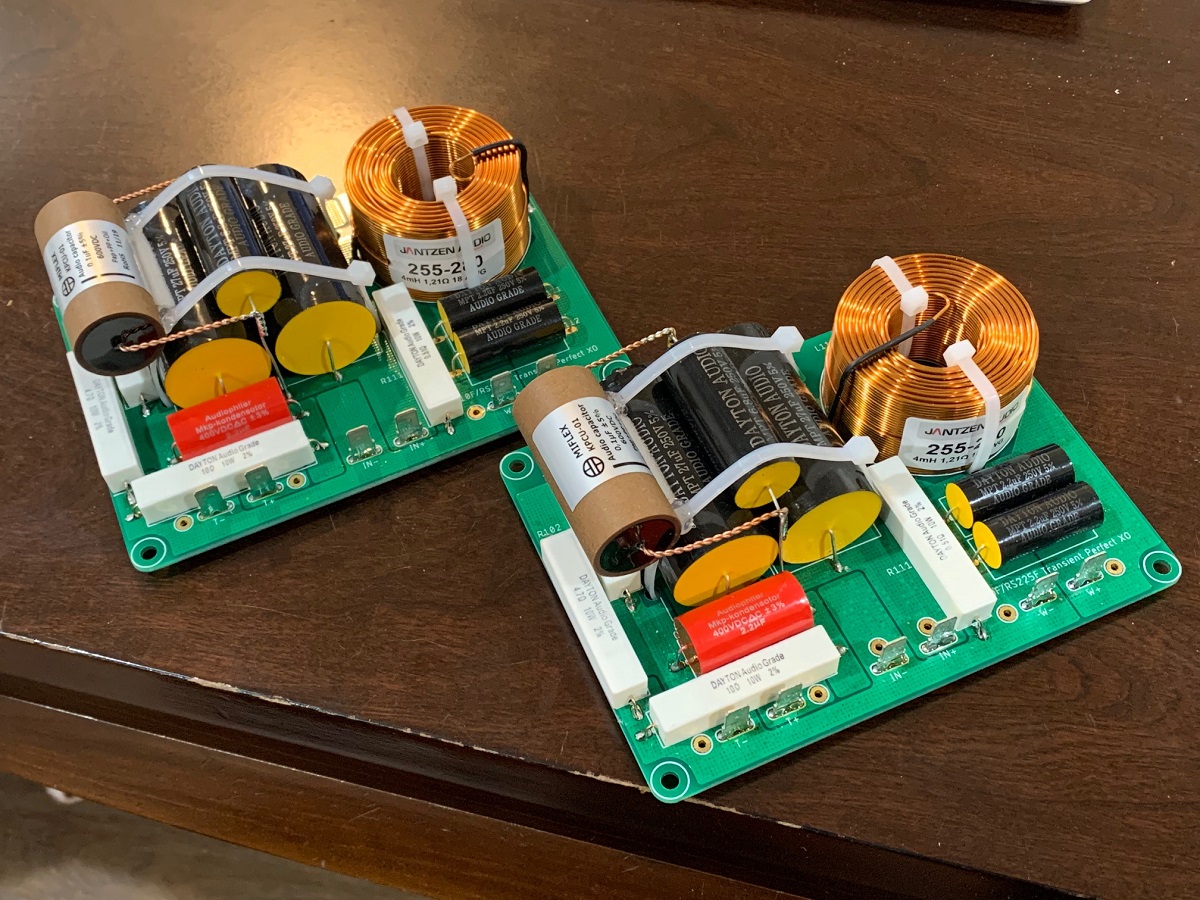

The next upgrade would be to change R1 and R2 to Mills 12w MRA resistors.
The next upgrade would be to change R1 and R2 to Mills 12w MRA resistors.
Attachments
- Home
- Loudspeakers
- Full Range
- 10F/8424 & RS225-8 FAST / WAW Ref Monitor
